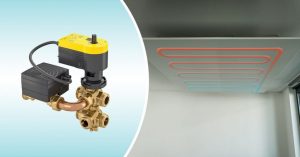SAUTER eValveco: Dynamic control for heating and cooling
SAUTER eValveco: Dynamic control for heating and cooling
The SAUTER eValveco system is used for automatic hydronic balancing in the full or partial load ranges as well as for real-time flow control. It replaces a static balancing valve in combination with a regulating/control valve or a ball valve. Two new controllers with BACnet MS/TP have been added to the product range.

HVAC systems play a decisive role in implementing energy objectives in the building sector. Trouble-free and energy-optimised heating or cooling not only results in a comfortable room climate. If the system runs in a reliable and balanced manner, it can reduce CO2 emissions and the building’s operating costs.
Interacting products from a single source
eValveco, the dynamic flow control system from SAUTER, is used in HVAC systems with variable flow. It consists of a flow meter, a regulating valve and an actuator, and controls the volume flow independently of pressure fluctuations in hydraulic circuits. Depending on the type, the products combine the functions of a pressure-independent control valve (PICV), a 6-way ball valve for the changeover function (heating/cooling), a balancing valve and a motorised shut-off valve.
SAUTER eValveco is designed for automatic dynamic hydronic balancing in real time, thus making additional balancing valves superfluous. The system maintains a perfect balance in the hydronic network in both full or partial load ranges. Without any additional components, it ensures that the exact amount of energy required is distributed to the right place at the right time.
Communication via Modbus and now also BACnet
The flow control system communicates via Modbus RTU in combination with a building management solution. eValveco UVC 106 is available in two new BACnet MS/TP versions: The UVC106BF015 with nominal diameter (DN) 15 and the UVC106BF025 with nominal diameter (DN) 20.
By means of direct integration into the building automation system with BACnet, the energy consumption of each room can be recorded in real time in management software such as SAUTER Vision Center. The values can be conveniently adjusted via computer, tablet or mobile phone. This not only brings transparency to the system’s energy flow, but also enables indirect costs such as CO2 tax on fuels to be reduced. Residents benefit from trouble-free room climate control and facility management is called upon less often for unscheduled maintenance in the event of faults.
You need to load content from reCAPTCHA to submit the form. Please note that doing so will share data with third-party providers.
More Information



